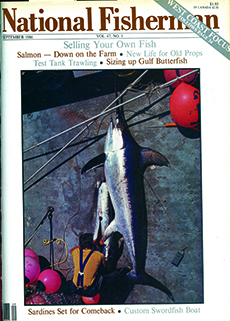In the September 1986 issue of National Fisherman, we ran a full feature on East Coast fishermen who had recently started to market their fish directly to customers instead of working through processors and marketers.
Fishermen from Maine to Chesapeake Bay and Florida were experimenting with marketing their own catch. Some were selling to consumers from roadside pickup trucks or leasing stalls on piers with high foot traffic. Others were marketing direct to wholesale restaurants, retail fish markets and supermarkets.
“Marketing, merchandising and product development were once foreign words to the fisherman. But he’s starting to have to come to grips with these things today in order to survive,” said Gene Connors, a former fisherman who was overseeing a New England Fisheries Development Foundation project at the time.
There were plenty of tales of fishermen renting U-Haul trucks to sell their catch out of and making double the money.
As you know, direct marketing hasn’t been perfected over the years. Not all fishermen are trying their luck on their own and making stacks of extra cash. But the experimenting continues.
Just this week the Peninsula Clarion ran a story about F/V Ounce out in Cook Inlet where “many of the salmon that wind up in the nets … have their buyer’s name on them from the moment they come out of the sea.”
Local fishermen Chuck Lindsay and Hannah Heimbuch operate Kenai Wild Salmon Company and deliver their catch to customers, usually within 12 hours of docking.
According to that report, about 31 fishermen currently hold direct marketing licenses in Cook Inlet and the initial permit itself only costs $25 and the time it takes to fill out a simple joint application for the Department of Revenue and Fish and Game.
When Bristol Bay was celebrating the two-billionth salmon caught in the fishery, Kenai Wild Salmon Company was posting to Facebook about the 2,000 pounds of salmon they managed to sell directly to Alaskans.
A lot of the company’s business is done through Facebook and over text message.
“We pick fish out of our net, and we’re like, ‘This is going to Kent,’” Lindsay told the Peninsula Clarion. “We’ll text him from our boat and say, ‘We caught your fish! Here’s a photograph.’ There’s that connection to the fisherman, to their fish. I think that a little bit can be lost with the direct marketing down to the Lower 48.”
Direct marketing certainly isn’t new, but the social technology available today sure does make it easier. Shooting a text message to your neighbor who buys from you regularly sure beats setting up shop on the side of the road.
If you’ve ever considered trying to sell your catch directly, be sure to check out the linked story and learn a thing or two from the pros. Maybe you’ll bring the next innovation to the table. I hear some people would sure like to watch their fish caught through a virtual reality headset somehow!







